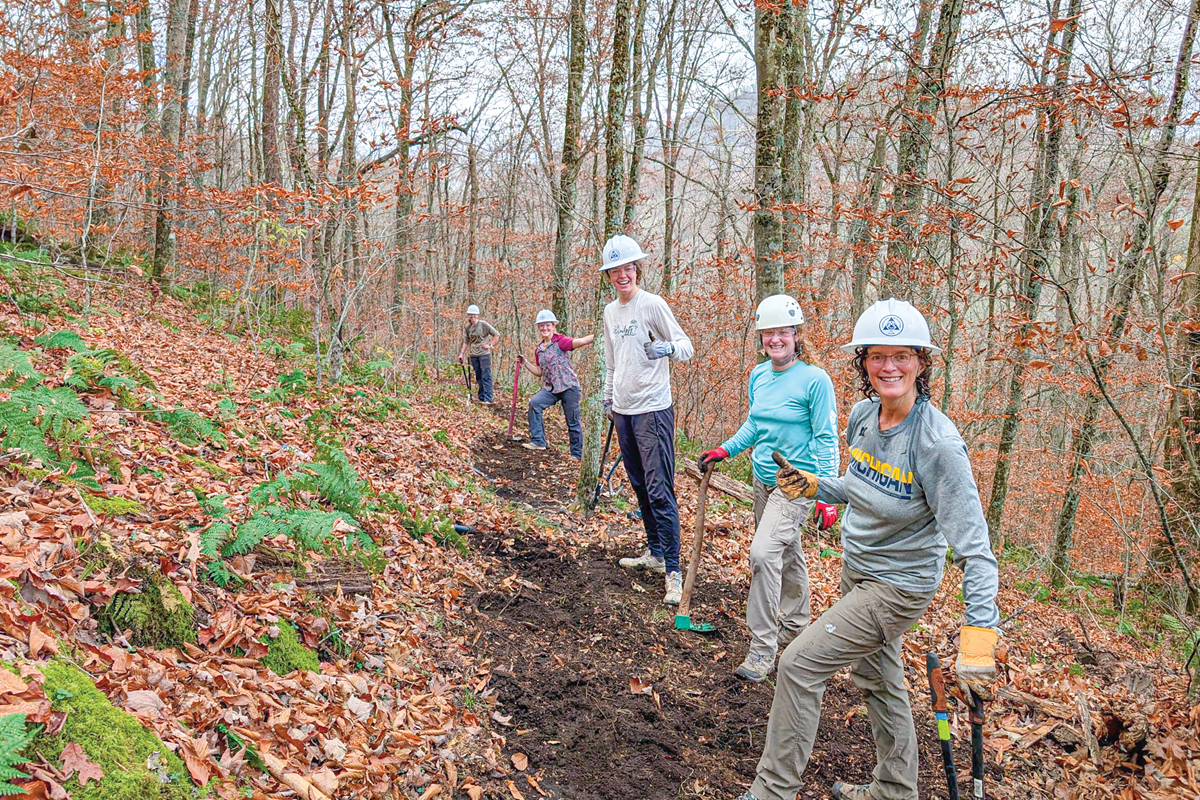Developer loses landmark lawsuit over shoddy roads
By most accounts, calling Art Williams a hands-on developer would be a pretty fair description. For decades, Williams was in the business of subdivision building, first in Florida and then in Western North Carolina.
In pretty much everything, his word was the final say. He picked the land to be developed, he divvied up the plots, he instructed engineers and construction crews. He even sold many of the lots himself.
Even as his health failed, said his wife Anne, her husband was routinely on the scene at the developments. His regular contractors said the same. He was there when the pavement was laid on the roads in Alarka Creek Properties, one of the Williams’ first developments in Swain County. And it was he who approved the words “state-approved paved roads” in brochures advertising the developments. He signed off on the erosion and sediment control plans for the 5.5 miles of roads that crisscross the development.
But it was not Williams who footed the bill when some of those roads began to deteriorate and slide from the mountains they were cut steeply into.
Of the homeowners in the subdivision, many bought their properties directly from Williams and believed the state-approved-roads pitch, until they were left with $40,000 worth of repairs and roads that were, in places, perpetually in peril.
This hadn’t been part of the purchase bargain. And in 2008, the costs and safety concerns reached a critical mass. The Alarka Creek Properties Homeowners Association took the late Williams’ Cane Creek Development Corporation to court, charging that he and his team misled them, saddling them with defective and dangerous roads.
Three years later, they won, to the tune of $3 million — the largest judgment court clerks had ever seen in Swain County — and threw into sharp relief the ongoing debate in Western North Carolina over steep-slope development and who is responsible when it falls, literally, to pieces.
What went wrong?
Alarka Creek Properties is a two-pronged development precisely 5 miles from Exit 69, just west of Bryson City. Its twin developments, Timber Creek Estates and Eagles’ Roost, sweep up the faces of neighboring mountainsides, cradling Alarka Creek neatly between them.
They’re not subdivisions in the traditional sense — there’s no pool or clubhouse, and most of the homes aren’t even within shouting distance of one another. They do have gates and a homeowners’ association, but really, the two developments are collections of retirement retreats and second homes, a mixture of already-built houses and empty plots that boast spectacular vistas of the surrounding landscapes.
The roads that lead to and connect them, though, aren’t for the faint of heart or fragile of vehicle. Sitting at the apex of Eagles’ Roost, facing down the mountain isn’t dissimilar to the slow crest of a rollercoaster’s first descent, peering down the long incline. They drop off steeply to one side and hug the sheer mountainside on the other. And though few cars are around to traverse the lanes, meeting one headed in the opposite direction can be a harrowing experience. The views are pastoral — the drive, less so.
The roads are anywhere from seven to 10 feet across. In places, there are signs of distress — fissures and cracking. They’re all passable now, but that hasn’t always been the case.
“We’ve had three multi-thousand dollar slides, we had a road that we had to move 2,000 feet of with blasting,” said John Foster, the homeowners’ association’s one-time president. “Ultimately, the road probably should not have been put in.”
That is, of course, only his opinion.
But, according to a study done by Bunnell-Lammons Engineering, a geotechnical firm out of Asheville, he’s at least partially correct.
There was never a dedicated, detailed road plan drawn up for Alarka Creek’s roads. Swain County doesn’t require one, and unless a developer plans on leaving the road in the state’s care, neither does the state.
There was, however, the required erosion and sediment control plan that detailed how the roads would meet state standards for erosion and run-off on the steep fill slopes — manmade grades with fill dirt pulled from the surrounding mountain.
It’s not a definitive road-building guide, but it spelled out the basic standards for what would be installed at Alarka Creek: road thickness, slope and drainage measures.
And, said the engineering firm, had developers and contractors followed the plans, the roads probably would’ve been fine.
But they didn’t.
Detailing the problems
There are, said the report, four basic reasons for mountain road failure: insufficient pavement thickness, insufficient asphalt compaction, slope instability and bad drainage.
In places, Alarka Creek’s roads showed all four.
Where the plans called for pavement to be two inches thick, in some spots it was only 1.5. They specified six inches of crushed stone under that pavement. Most roads averaged only 5.4. One had barely more than an inch.
Ninety-five to 96 percent compaction is industry standard for a fill slope — unlike the mountain’s native soil, it hasn’t had thousands of years to build up its structural integrity. The more densely packed, the less likely it’ll move around, cracking and sliding. That’s what the plans called for, too.
Most of the subdivision’s roads averaged between 84 and 89 percent compaction.
And then there’s the slope.
The state recommends a two-to-one, horizontal-to-vertical slope ratio at minimum for a safe road. And again, that’s what appeared on the erosion control plan submitted to the North Carolina Department of Natural Resources.
But the engineering firm found some of the slopes to be as steep as one-to-one.
“The roadway fill embankments evaluated have a significant potential for instability because the roadway fill embankments are constructed of loose fill that have a steeper slope inclination than fill soil conditions can support,” read the summary report.
In other words, you can’t have loose dirt and a steep road, too, or eventually, you won’t have a road.
“When you have slopes too steep and base and asphalt too thin, the roads are going to fall apart,” said Dan Bryson of Raleigh, the lead attorney on the homeowners’ side. The case, he said, was simple — poorly constructed roads sold through false advertising.
“When they showed homeowners paved road as an inducement to sell, it was a bait and switch,” said Bryson. “There was significant engineers’ testimony that these roads were not built pursuant to local standards. When you build a road, there’s just some basic things you have to do. And it’s going to take a little bit longer, but you just need to do it right.”
Anne Williams, Art Williams’ widow, disagrees with those assertions. As the sole owner of Cane Creek Development, she is the defendant.
Bryson and his legal team pointed to the multiple slides and alligator cracking — patchwork cracks that resemble the crusty reptilian pattern of an alligator’s back — as signs that the roads were faulty from the outset.
“But that’s typical of all roads in [Western] North Carolina, when you pave them,” said Williams. “All the other evidence was that we had done the right thing, we’d done the best roads we could do. State roads slide all the time, and 90 percent of that road is there the same way we built it.”
Could they have gotten a geotechnical engineer, like BLE, to come and test the sites before the road was laid? Sure, said Williams. But no developer does that, she said; it’s too cost prohibitive.
“You‘re selling lots to average people. This is not a country club setting,” said Williams. “We wanted to build in a way that the average person could buy and have a second home, not what we always called the ritzy ditzy.”
Plus, she said, they knew what they were getting.
“They all personally signed [a statement] that they understood that these were private roads and they were inferior to state roads and that the burden of keeping up the roads would be on the homeowners’ association,” said Williams.
And regardless of the roads’ initial construction, that much is true. Which points to a problem facing not just Swain County, but every mountainside subdivision in the region.
Caveat Emptor
Paul Carlson is a man familiar with degraded land. He’s the executive director of the Franklin-based Land Trust for the Little Tennessee, a non-profit group that works in land preservation. He is concerned about the glut of developments in WNC such as Alarka Creek, where steep lots connected by questionable roads have now fallen to owners to maintain. And those owners may not have always done their homework.
“Perhaps they hadn’t done significant due diligence to find out what they’re getting into, and now collectively own a liability,” said Carlson. And what then? “With poorly designed road systems on these properties, every year that passes the liability is increasing. Well, who’s going to be responsible for that stuff?”
That’s a question that legal precedents like the Alarka Creek case are looking to settle, but historically, a lot of homeowners have been left holding the bag on decaying roads they didn’t think they signed up for.
John Foster certainly didn’t. When he bought his plot in Alarka Creek, he didn’t dream Williams would sell him a lot on an unsafe road. But he didn’t look too far into it, either.
“I thought it was steep, but again with the advertisement of state-approved, I thought, ‘OK, if the state of North Carolina is going to approve this, then I’m OK with it,’” said Foster. “We did sign a release, but what we understood was we were going to maintain the roads, but we were going to be given roads that were maintainable.”
But this, of course, is not actually a given.
The truth is that, when it comes to private roads, no one is really checking.
During pre-trial interviews, lawyers asked that very question: is there anyone who makes sure these roads are being constructed properly? A state agency? Local authorities? A retired volunteer? Anyone?
“When you construct a house, you have an inspector come in and say ‘this house is substantially complete and it has been constructed in conformance with the plans and specs submitted on file’… to your knowledge, there is no one who does that for roads or private roads?” Bryson’s fellow attorney Scott Harris asked Victor Lofquist, a civil engineer in Sylva who did the erosion plan for Alarka Creek and most of Williams’ other projects.
“Not that I am aware of anywhere,” replied Lofquist.
Doug Parker, the excavator who helped install the roads, replied similarly.
“To my knowledge, there is no equivalent to that (a building inspector) on a road development project,” said Parker.
And that’s become pretty clear in the years since mountainside developments began to see their vogue.
Roads have been splintering and slipping off the hills in subdivisions around the region, and local officials began to realize that maybe someone should, in fact, be looking.
Road Regulation
Enter subdivision ordinances, those controversial local laws that give officials a little more power over what’s going up in their jurisdiction and how it’s built.
Haywood County has one that limits cut slopes to 1.5 to one, and spells out things that state erosion control standards do not, such as no organic matter in roadbeds; it will decompose and crack holes in the street. And they keep tabs to make sure it’s all being done according to plan.
“What would happen is if somebody built a subdivision road here that was subject to the erosion control law is you would submit your plan to us, we would give you approval, we would inspect it periodically. Then we do perform a final inspection,” said Marc Pruett, erosion control program director in Haywood County.
In Jackson County, a similar ordinance was passed, drawing some ire from developers in a locale heavy laden with second homes peppering the steep mountain faces.
But when it comes to such laws, there is a schism in the church of steep-slope construction.
Parker told attorneys in his deposition that those regulations helped grind his subdivision road-building work to a halt in Jackson County.
“We used to (build roads) a lot until we had a subdivision ordinance in this county and then it came to a stop,” said Parker. “Pretty much everything in this area that stopped developing because there was restraints of subdivision ordinances.”
Swain County has no such regulations. There was some movement on the idea around 2007. A committee was even formed, spurred by the news that emergency vehicles couldn’t traverse some of the county’s dicier residential roads. Recommendations were made, but nothing ever came of them. Swain commissioners apparently lacked the political will, in a county that doesn’t even have a planning board.
In neighboring Macon County, a so-called steep slope ordinance is in talks. Macon is dealing with the aftermath of the Wildflower development, which is the apocryphal, when-roads-attack story that seems to drift into most steep-slope conversations.
Wildflower was a behemoth of a development on the side of Cowee Mountain that broke ground in 2005, at the height of the mountain real estate upswing. At the time, it was controversial, but only because local residents feared such an influx of inhabitants would overstretch their resources.
Four years later, most of its lots were in foreclosure. Then the ground broke on it: One of its key thoroughfares collapsed, a landslide followed and a subsequent geological survey cast serious doubt on the rest of the roads in the place. Downslope residents were warned to brace for debris in case of extreme weather.
The neighborhood’s manager defended the roads, calling the collapse an isolated incident and pointing to the fact that the rest of the roads had erosion control approval.
But so, presumably, did the decimated road.
Finding solutions
Back on Alarka, the victorious homeowners are not yet rejoicing. Anne Williams maintains that she is an 81-year-old widow who had nothing to do with the roads’ construction and has no money to pay $3 million for their repairs. She said her refusal to settle with the homeowners wasn’t stubbornness, but insolvency.
“The fact is we lost on Alarka. We may have put in $3 million, but none of it came out of the profit. We have not had to pay income tax for profit reasons for at least five years, if not longer than that,” said Williams. She said she’s closed Cane Creek Development, laid off the staff and headed back to Florida to live off her Social Security.
Dan Bryson, however, thinks Williams’ cries of poormouth are, at best, disingenuous. He’s starting another proceeding against her that, in legalese, is called ‘piercing the veil.’ Basically, he’s going after all the other corporations she has, trying to draw some of the sizeable settlement from them.
In the rest of the region, though, the problem of unstable roads persists, though subdivision ordinances and the economy are cutting down on the number of new substandard streets going down.
Gordon Small, who works with the Haywood Waterway Association, is working on a project to help new developers find the most suitable road locations in the first place, rewarding them with a certification if they follow expert suggestions.
“The No.1 source of non-point pollution — or mud in the creek — is roads,” said Small. His group is trying to get county commissioners to get on board with the idea.
“You can’t observe this and not be concerned about that,” he said. “People are beginning to recognize that it’s to their advantage to know what’s going to move and what’s not.”
Carlson, with the Land Trust for the Little Tennessee, said he’s looking toward an inventory of the region’s perilous roads, so at least they can be monitored for movement.
“Clearly in [the last] decade up until 2008, it was absurd to try to make the argument that the highest and best use of steep-slope land was for forestry, but now it’s kind-of interesting to revisit the question,” said Carlson. “I think a lot of these lands — the most marginal, steep, remote lands where these roads were punched in — it may be that no one wants them.”
And for developers still around, the Swain County jury’s decision is ringing clearly through the mountains.
“I think these jurors are tired of developers who come in, deface the mountains and then put in substandard roads, sell out all the lots and then try to avoid liability,” said Dan Bryson. “I hope that this judgment sends a signal to every developer: if you pave a road on a mountain in Western North Carolina, it needs to be done properly.”
Swain commissioners retool strategy in fight over Fontana dam payments
Swain County commissioners have taken back a request made to the General Assembly in February, in hopes of bolstering their lawsuit against neighboring Graham County over payments on the Fontana Dam.
Both counties get payments from the Tennessee Valley Authority in lieu of property taxes for the bits of the dam and hydropower generators that are in their respective counties. They have been locked in battle recently over how much each is entitled to.
Last fall, the N.C. Department of Revenue said the payments were being calculated wrong, and that Graham was entitled to a larger chunk of the funds. Swain lost more than $200,000 a year under the new formula for TVA payments.
Graham proceeded to file suit against Swain, looking to recoup 60-plus years in back TVA revenue that was misapplied to Swain under the old formula.
So Swain fired back, filing a countersuit and sending a resolution to Raleigh asking for a change in the way payments are calculated.
The payments were once split equally. The new formula gives a greater share to Graham, since more of the dam and generators lie on Graham’s side of the county line.
Swain proposed yet another new formula based on how much property each county lost when the lake was created in the 1940s.
That would bring a lot more revenue to the Swain side, because, according to County Manager Kevin King, Graham only gave 19,000 acres as opposed Swain’s 55,000 back when the lake and dam were built.
But, said King, the measure never got out of committee in the House of Representatives, stymied at every turn by Rep. Roger West, R-Marble, who represents Graham.
King said the county still stands behind the idea.
“Any time you have a county that’s suffered, that the TVA has taken 55,000 acres away from and the other county only got 19,000 taken, any county would say that’s wrong [to be compensated less],” said King.
But Kim Lay, Swain County’s attorney, apparently told commissioners in a 15-minute closed session to discuss the litigation that rescinding the request for legislation, since it died in committee anyway, would be better for Swain when it comes to the legal suit.
The legal claim is still in the discovery phase, and King said he expects movement on the issue over the next few months.
Swain DSS to meet to discuss director’s possible dismissal
For now, Swain County Department of Social Services Director Tammy Cagle still has her job. But that might soon be in question after a decision made by the county’s DSS board Monday night.
Supporters of the suspended Cagle gathered at the board’s meeting, speaking out in her favor before board members entered an hour-long executive session to discuss Cagle’s future with the department.
In the end, the five-member board voted unanimously to call Cagle back to a hearing later this month “to consider dismissal.”
Cagle herself spoke in her own defense prior to the closed session, telling board members that she’d never instigated a cover-up in the department, as has been alleged by former social worker Craig Smith.
Smith, who was placed on leave and has now resigned his post, told investigators that Cagle and Program Manager T.L. Jones ordered him to falsify reports following the death of Aubrey Littlejohn, a 15-month-old Cherokee baby who died in January despite repeated visits from DSS representatives. Cagle was suspended from her post while an investigation into the baby’s death was undertaken.
“I realize that my silence for so long has been a mistake,” said Cagle, going on to defend her agency and its actions. “Have I made mistakes and am I still learning as a director? Absolutely. Have I led or participated in any cover-up or falsification of records with this agency? No, absolutely not.”
Cagle was joined at the podium by family members and former DSS clients, who praised her merits as a director and a social worker.
Also present, though, were some from Aubrey’s family, asking that her memory not be forgotten and that Cagle be held accountable for how DSS handled the case.
“I’m here because of our child that died, we can’t bring her back. She [Cagle] can go out and get another job, we can’t get our baby back,” said Ruth McCoy, Aubrey’s aunt. McCoy said she was disappointed by the board’s inaction on the matter.
“I mean, I thought they were going to take action on this tonight, but it seems like they’re just going to discuss it,” said McCoy. “It seems like the people that came out to support her were more angry about our family and her job than about what happened.”
And some who came to back Cagle did lay the blame for Aubrey’s death on her family, rather than on DSS.
“I can’t blame other people for what happens to my children. They knew how Ladybird [Powell, Aubrey’s caretaker] was all of her life, her entire life, now why didn’t they go get that child when it was first put there in the beginning?” asked Eunice Washington of Aubrey’s family.
While eight people shared their thoughts on Cagle’s fitness to lead the organization, the board itself remained quiet on the issue. They called Cagle in for discussions, but said their only comment would be to schedule a hearing to discuss Cagle’s possible dismissal.
It’s not only been the staff, but the DSS board too has seen upheaval in the aftermath of Aubrey’s death.
After a tense closed session in March, when the board deadlocked on whether to suspend Cagle and Jones, most of the board turned in their resignations under pressure from county commissioners. But they didn’t go down quietly, taking to the podium at a commissioners’ meeting to berate that board for denigrating them publicly.
Currently, three of the five social services board members are just over two months into the job. Frela Beck and Robert White, also a county commissioner, are the only remaining members.
Some asked why Jones, Cagle’s second-in-command, had been allowed to stay on, while the director was put on administrative leave with pay.
Jones and two of the other four employees named in an SBI search warrant issued in an investigation are still on board with the department. They have, however, been asked by the Eastern Band of Cherokee Indians to stay away from the Qualla Boundary, instead sending other social workers to handle cases there.
The DSS board has called a pre-disciplinary hearing for June 21, where they said they’ll talk to Cagle about her future with the department.
Social worker resigns
Craig Smith, the Swain County social worker named in a recent SBI investigation, has resigned from the Department of Social Services.
Smith came under scrutiny during a probe by the Swain County Sheriff’s Department and the SBI into the death of 15-month-old Aubrey Littlejohn. Smith was Aubrey’s caseworker and visited her home several times prior to her January death, though he took no steps to remove her and made no follow-ups.
After her death, Smith falsified records to make it appear that he’d kept up with the child. He told investigators that he did it at the direction of his superiors, including Program Manager T.L. Jones and suspended Director Tammy Cagle.
Investigations by the SBI and an internal social services investigation are still underway.
Swain citizens might get seat at the table as North Shore money trickles in
After a decades-long battle to get it, the first interest payments on Swain County’s North Shore Road settlement are finally starting to trickle in.
Now to figure out what to do with it.
Of the $52 million payout, given to the county by the federal government as a consolation prize for a road that was promised in the 1940s but never built, $12.8 million is already in the bank. There’s another $4 million that’s promised this year — it’s in President Obama’s budget, anyway — although it could be a while until it finally makes its way into the county’s hands.
But after the long and arduous negotiations that led to the settlement, and speculation from all sides over what should be done with the money, there is, as yet, no plan for the interest that’s accruing on the settlement cash that’s already in the bank.
When an agreement was reached last summer, the idea of a steering committee peopled by community members was bandied about, with the intent of directing the county on the best use of the money. County Manager Kevin King said it’s a concept that has been mentioned in the intervening year by a few commissioners and community members, but no one’s formally proposed it in the commissioners’ twice-monthly meetings, so the cash is still sitting there. No committee has been formed, either.
But, said King, there’s not much money to spend yet, anyway. He estimates the fund will make around $200,000 in interest this fiscal year, which will be paid out at the end of June.
“Of course right now, with the economy, it's not drawing a lot of money,” said King. “It'll take a while to increase to the point at where they could do something with it.”
The funds are held in trust for the county by the North Carolina Department of the Treasurer, with only the interest remitted to the county each year. This year the interest has averaged less than 2 percent.
“If it was making more interest, it would probably be further on the front burner,” said Leonard Winchester.
Winchester is the chair of a group called Citizens for the Economic Future of Swain County, and he’s been instrumental in getting the money secured for the county and wants to see citizen input on how it is spent.
“I am in favor of a committee doing it. It's just that there's not that much interest there to be dealt with and so it's not been a hot topic,” Winchester said.
Commissioner Robert White concurs. He’s one of the commissioners in favor of a citizens group.
“We haven't accrued enough yet, but I assure you what I would love to see would be a citizen committee to look at this particular situation,” said White.
His vision is that the money would be used for special projects in the county, things that could never be done otherwise.
“My vision for that North Shore money is once we get enough accumulated, I want to see things that are going to improve Swain County in whatever manner that it may take. You also really have to look and see about things that could really step the county up another level,” said White.
A small portion of the interest money has already been spent, going to erect five commemorative granite pedestals in front of the county’s administration building, one detailing the North Shore Road saga. The project cost around $20,000, with $7,500 covered by a National Heritage Area grant and the rest of the bill footed by the interest money.
Nothing bigger, however, has been proffered as a potential project. King said he’s in no hurry to rush a decision on the funds, especially in this economy.
“At this point, we're just trying to let this grow,” said King. “And with the economy like it is, it's almost impossible to bank on any investments right now.”
Cause of infant’s death ‘undetermined’ by autopsy
Hypothermia is a possible cause of death for Aubrey Kina-Marie Littlejohn, a 15-month-old Cherokee baby who died in January, according to a state autopsy report released last week.
The autopsy also showed indications of multiple bruises to the head and a broken arm.
Relatives had repeatedly warned Swain County Department of Social Services of suspected abuse and neglect by the baby’s caretaker, but DSS failed to take action. Swain DSS is now under investigation for an alleged cover-up, including falsifying records to hide any negligence on their part.
Aubrey had been living in a trailer with of her great aunt, Lady Bird Powell, 38. Relatives say there was no heat in the trailer. When Aubrey was brought to the Cherokee Indian Hospital the night she died, she was dressed in only a T-shirt. Her core body temperature was only 84 degrees and she was pronounced dead shortly after arrival.
The doctor performing the autopsy could not decisively pinpoint a cause of death and officially deemed it “undetermined.”
“The cause of death certainly wasn’t obvious,” said Dr. Donald Jason, a pathologist at Wake Forest University Baptist Medical Center.
However, hypothermia remains a possible cause of death.
“We certainly have not ruled out hypothermia,” Jason said.
Hypothermia is difficult to confirm unequivocally through an autopsy and requires “a thorough scene investigation to support a cause of death as hypothermia,” Jason wrote in his report.
It will ultimately take “really good police work” to figure out what happened, Jason said.
“Just like in all science, one has a hypothesis that can be formed from what people say happened or reasonable guesses. The autopsy is one test,” Jason said.
Law enforcement failed to take the temperature inside the trailer. Their reports merely reflect that it was “cold,” Jason said.
Swain County Sheriff Curtis Cochran said the investigation has not been called off just because the autopsy came back with an undetermined cause of death.
“We are still investigating. When the investigation is concluded, we’ll sit down with the District Attorney’s office and determine what if any charges will be coming out of this,” Cochran said.
While the autopsy did not confirm homicide, it likewise did not confirm death from natural causes.
“Questions have been raised. I don’t think they are answered by the autopsy alone,” Jason said.
The autopsy showed multiple bruises to the head that seem to have occurred within a day prior to death. It would not have been possible to receive all the bruises from a single fall, Jason said. However, whatever struck the child’s head was not severe enough to be linked to the cause of death or to the brain swelling.
It also revealed that both bones in Aubrey’s forearm had previously been broken. The break was consistent with a blow to the forearm, rather than a fall, Jason said. Jason said the injury would have been quite noticeable, however, Aubrey was never taken to the hospital or a doctor for it, according to law enforcement records.
In addition to claims by family members who say DSS had reason to suspect abuse and neglect but failed to act, court papers involving other children in Powell’s care reveal that Swain County social workers had reports of physical abuse of Aubrey months before her death.
Social safety net failed Cherokee baby
Additional evidence has surfaced indicating Swain County social workers failed to act on reports of alleged abuse and neglect of a Cherokee baby who later died.
Court papers reveal that Swain County social workers had reports of physical abuse of Aubrey Kina-Marie Littlejohn by her caregiver, Ladybird Powell, months before she died in January.
The papers were filed by the Jackson County Department of Social Services in a custody case involving another child in Powell’s care.
Powell’s treatment of Aubrey and her still unexplained death weighed heavily in a petition filed by Jackson DSS to have an 8-year-old boy removed from Powell’s custody.
Although Powell lives in Cherokee, the tribe does not have its own agency to handle child abuse and neglect cases. Instead, the child welfare divisions of Jackson and Swain DSS manage cases on tribal land. Previously, Powell lived on the Swain County side of the reservation, so the case fell to Swain DSS.
But Powell has moved, as has the 8-year-old boy, who now lives on the Jackson County side of the reservation, giving Jackson DSS jurisdiction.
The petition filed by Jackson County DSS reveals the following:
• Swain DSS initiated an investigation into suspected child abuse and neglect involving Aubrey in November 2010. (This was the second such investigation in three months. Until now, however, only the first had been made public.)
• The report of abuse made to Swain DSS in November claimed that Powell “smacked Aubrey in the mouth when she cried and jerked Aubrey around,” and “knocked Aubrey off a bed intentionally.”
• Swain County social workers visited Powell’s home three days after the report came in. They had Powell sign a statement saying, “Ladybird will not physically punish Aubrey.” Aubrey was 13 months old at the time.
The first investigation of abuse and neglect by Swain DSS was in September. In that case, Powell claimed bruises on Aubrey were the result of a fall down the stairs.
A DSS worker deemed the report of abuse “unsubstantiated” after one visit to the home. While he told Powell to take Aubrey to the doctor and have her injuries examined, he never followed up to see what the doctor found — or whether the doctor’s visit even took place. He later fabricated a report claiming Aubrey had been seen by a doctor when in fact she never had, according to law enforcement records.
Swain County DSS is under investigation by the State Bureau of Investigation for an alleged cover-up. An interim director has been brought in, and three DSS board members have been replaced.
Ruth McCoy, one of Aubrey’s great-aunts, said there were other complaints from relatives ignored by Swain DSS — one of which she observed firsthand.
In November, McCoy heard from a relative that DSS had shown up at Powell’s trailer to take away a 10-year-old boy who was living there at the time. McCoy drove over to the trailer and implored the DSS workers to remove Aubrey as well. There was no heat in the trailer, and it was obvious to the social workers, McCoy said.
“The social workers were sitting there on the couch with their hands clasped between their legs to keep warm,” McCoy said.
One of them was Swain DSS Program Manager T.L. Jones, second in command at the agency. Jones even went out to his vehicle to get a jacket, McCoy said. Meanwhile, Aubrey was dressed in a jacket and toboggan inside the trailer. McCoy asked if Jones was going to take Aubrey, too.
“I said ‘What about her?’ and he said, ‘That’s another case.’ They were removing a 10-year-old and there was no heat but they didn’t take her,” McCoy said.
The night of Jan. 10 when Aubrey died, emergency room doctors at Cherokee Indian Hospital recorded her core body temperature as only 84 degrees, according to law enforcement records.
The reason for removing the 10-year-old was documented as drug and/or alcohol use by the caregiver, according to a Swain DSS report. The caregiver listed on the report was the boy’s biological mother, Mel Toinetta, who was living at the trailer with Powell.
The 10-year-old was placed in the care of McCoy.
Autopsy still pending
Doctors at Cherokee Indian Hospital the night Aubrey died suspected drugs may have been in the baby’s system and contributed to her death, according to the Jackson DSS petition.
No charges have been filed against Powell in connection with Aubrey’s death. An autopsy report, including a toxicology report, is still pending. The autopsy and toxicology report have been completed, but have not yet been reviewed and cleared for public release. The Smoky Mountain News has filed a request to receive a copy of the report when it is made public.
It appears Swain DSS was waiting for the results — which should clarify a cause of death — before deciding what to do about Powell’s custody of the 8-year-old boy.
The day after Aubrey’s death, a Swain DSS worker visited Powell’s trailer to check on the boy. Powell had legal custody of the child since he was 2. Recently, he had been living with Powell on and off, but seemed to be spending more time lately at the home of Powell’s ex-husband.
That must have seemed preferable to the case worker, as she wrote in her report that the boy should live with Powell’s ex-husband rather than Powell “until notified by DSS.” But that was crossed out and replaced with “until the toxicology report is in.”
Powell made derogatory and threatening comments to Swain social workers over the pending toxicology report, including that she would make them “eat the results when they come back negative,” according to the court petition.
The boy’s school expressed concern over the informal arrangement that placed the boy with Powell’s ex-husband. Since Powell still had legal custody, the school had nothing on file to prevent her from picking the boy up.
Jackson DSS apparently does not approve either, deeming the temporary placement with Powell’s ex-husband an inappropriate child-care arrangement, according to the petition filed by Jackson DSS alleging neglect of the boy.
The petition states that the boy “lives in an environment injurious to the juvenile’s welfare.”
Swain commissioner got DSS aid while niece was agency’s director
A county commissioner got financial aid from the Swain County Department of Services last year while his niece was serving as the DSS director, prompting the development of a new conflict of interest policy.
The new policy prohibits the DSS director from approving benefits for family members. At least three family members of DSS Director Tammy Cagle got financial payments from the agency — including her uncle, County Commissioner Steve Moon.
Cagle’s role in approving the benefits was questioned by the DSS board last October but they found no wrongdoing, according to board members.
“The board met and we reviewed each instance, and we found no illegalities concerning either state or federal policies. We reviewed it very carefully, but everything was above board,” said Bob Thomas, a former DSS board member. “It was maybe a question of judgment, but there was nothing illegal about anything that was done.”
Moon received financial assistance from DSS after his house burned down last year. Moon said he does not know whether Cagle personally signed off on the aid. His wife made the application, he said. Moon owns a tire store and his wife has a job with the school system.
Cagle was recently suspended with pay due to an unrelated investigation of the agency by the State Bureau of Investigation. DSS workers have been accused of a cover-up following the death of a Cherokee baby in an attempt hide potential negligence on their part.
Moon was the lone county commissioner who believed Cagle should remain in her post during the SBI investigation. County commissioners voted 4 to 1 to call on the DSS board to put Cagle on administrative leave after she was named in a search warrant. Moon did not recuse himself from the vote even though Cagle is his niece.
The names of Cagle’s other family members who received benefits, and the amount they received is not public record.
Cagle’s home phone number is not listed. Attempts to contact her through DSS’ attorney were unsuccessful.
Change in policy
Minutes of a DSS board meeting last October show the board discussed the issue in closed session, citing confidential personnel matters as the reason for closing the meeting.
Upon coming out of closed session, however, the board announced that Cagle had done nothing wrong. The board passed a resolution affirming support for Cagle.
“The Swain County DSS board fully supports the director in performing the duties as required by the county, state and federal guidelines,” the resolution stated.
Cagle then “expressed her appreciation of the board’s support,” according to the minutes of the meeting.
The following month, however, the board passed a conflict of interest policy that prohibits the director from approving assistance for family members or signing their benefit checks.
“At no time will the Director be involved with the decision making process of determining eligibility for any program,” the new policy states.
Family members of the director must apply through the same outlets as the public would — namely with the supervisor over the specific aid program they are applying for, whether its food stamps or one-time emergency rent assistance. In addition, the program manager, who serves as second in command for the agency, must approve the benefits and sign checks made out to the director’s family members.
The purpose of the policy was to prevent Cagle from being in a situation where she would have to explain or justify herself, according to Jim Gribble, a DSS board member at the time.
“We just wanted to remove any suspicion toward her for approving anything for her family,” Gribble said.
The conflict of interest policy was approved by the board in November and devised with input from a state DSS liaison.
Thomas said the same protocol should extend to any DSS worker.
“Anything involving any employee’s family needed to be served by someone other than a family member,” Thomas said.
Thomas and Gribble said the issue was first raised by the county manager or county commissioners, who expressed concerns about benefits being paid out to Cagle’s family members.
“There were a couple questions raised by commissioners as to whether assistance given was legal or not,” Thomas said.
Gribble said the questions were raised by the county manager.
While the DSS board cleared Cagle, it does not appear the DSS board independently verified whether the particular family members qualified for the benefits.
When asked if they were eligible, Gribble said “I assume so,” but added that, “The board doesn’t do eligibility.”
Since the specific benefits are not public record, it is not certain what aid program Moon tapped after his house burned down.
Moon said it was emergency assistance. However, he would not be eligible for that program according to the guidelines. Emergency assistance provides money “for families in short-term financial crisis due to unusual circumstances,” but the household must have a child under the age of 18 and be living below the poverty level, according to the eligibility guidelines.
Interim director takes charge of Swain DSS amidst ongoing investigation
An interim director is now at the helm of the Swain County Department of Social Services, bringing to the table an impressive resume with a focus on child welfare.
“That was real important to us,” said Georgianna Carson, a newly appointed DSS board member.
Jerry Smith served as a DSS director for 25 years in three different counties, including a year as president of the North Carolina Social Services Association. He also worked as the director of a children’s home after retiring from DSS and has written two books about foster homes and orphanages.
Smith’s background in child welfare is notable given the controversy surrounding the embattled agency. He is stepping in for former director Tammy Cagle, who was put on administrative leave with pay during an investigation into the death of a Cherokee baby. DSS failed to remove the baby from her caretaker and later conspired to cover up their own negligence, according to law enforcement records.
Four of the five DSS board members are new following resignations of former board members in the wake of the controversy.
Smith’s past experience as a DSS director is also critical. He knows the intricacies of the agency — with its maze of state and federal funding formulas and stacks of manuals that prescribe state and federal laws and policies.
“He is going to be a real asset for Swain County,” Carson said.
Smith was brought on board just two days after Cagle was put on leave. County leaders already had been in contact with the state Department of Health and Human Services to help identify a candidate to take over the agency.
The DSS board can’t say when, or if, Cagle might return to her post, or how long Smith will remain in place.
“He is going to be here as long as we need for him to be. I feel for sure it will be several months,” Carson said.
The agency is conducting its own internal investigation independently of the SBI, according to Justin Greene, the attorney for Swain DSS. That internal investigation will presumably determine whether any employees should be disciplined or terminated.
For now the county is having to pay Smith’s salary on top of Cagle’s, who is only on administrative leave. The county has a contract with an executive staffing firm for Smith’s services at the rate of $60 an hour, a portion of which the firm likely keeps as commission. That translates to an annual salary of $124,000.
As for the SBI investigation, no one knows when it will end.
“There is no way for us to speculate how long the investigation may take,” said Jennifer Canada, a spokesperson for the N.C. Department of Justice. “Once it is complete, the SBI will turn over a report of its finding to the local district attorney for review. The DA will determine whether to file any charges.”
Carson said the death of the baby in January is a tragedy and needs a thorough and unbiased investigation, but it should not define DSS.
“Justice has got to be served, but at the same time we have got to mend fences,” Carson said. “I think people have gotten so focused on this one issue they have forgotten that this agency does so many things for the people of Swain County. We have so many good employees.”
Other DSS changes
Meanwhile, the chain of command for DSS Attorney Justin Greene will be altered. He will answer directly to the DSS board rather than the director. The SBI investigation and the turmoil leading up to Cagle’s suspension revealed the potential for conflicts of interest if Greene is under the director’s command.
The DSS board meets the last Monday of the month at 5:30 p.m. The old DSS board would only allow members of the public to speak if they requested to do so in writing two weeks prior to the meeting, and even then they could be turned down if their topic wasn’t considered fitting. While county commissioners and town boards are required by law to have public comment periods, appointed bodies like the DSS board are not.
Nonetheless, the new board has changed the policy and will allow anyone to speak up to five minutes.
“We know we are not elected officials, but at the same time we are there to serve the people of Swain County and we didn’t want to seem like we were being aloof or unable to be contacted if need be,” said Carson.
Who is Swain’s interim DSS director?
Jerry Smith has his masters in social work from UNC-Chapel Hill, considered among the best in the field nationally. From 1973 to 1997 he served as a DSS director in Washington and Wilson counties in North Carolina and Tazewell County in Virginia. He served as president of the N.C. Social Services Association in 1990. After retiring from DSS work, he was the director for two years at Holston Methodist Home for Children in Knoxville, Tenn., and has continued to provide services there as a trainer. He is the author of two books about foster homes and orphanages.
New board and new director take reins at Swain DSS amidst SBI probe
The director of Swain County Department of Social Services has been put on leave with pay following a nearly clean sweep of the DSS board.
A newly constituted DSS board placed Director Tammy Cagle on “nondisciplinary investigative status to investigate allegations of performance or conduct deficiencies” following a unanimous vote of the DSS board Monday (March 28).
DSS plans to hire an interim director by the week’s end, according to Robert White, a Swain County commissioner and new member of the DSS board. The DSS board will meet Wednesday to consider a person for the post.
White, a former school superintendent, said the entire situation has been very difficult, in fact the most difficult he has ever faced. White said he hopes it can be resolved sooner rather than later.
Swain DSS is under investigation for an alleged cover-up following the death of a Cherokee baby, Aubrey Kina-Marie Littlejohn. Relatives had repeatedly warned DSS of suspected abuse and neglect by the baby’s caretaker, but DSS failed to take action and later doctored records to hide any negligence on their part, according to the law enforcement investigation.
So far, no charges have been filed against Aubrey’s caregiver in connection with her death, nor have charges been filed in the obstruction of justice investigation into DSS.
Despite public demands that those employees named in the investigation — including the director — be put on leave with pay pending the outcome, the former DSS board reached an impasse on whether to do so.
Swain County commissioners condemned the former board for failing to take action and called for them to resign.
Four of the five DSS board members are now brand-new through a combination of local and state appointments: Georgeanna Carson, Tom Decker, Sarah Wachacha and White. Only Frela Beck remains from the previous board.
The DSS board only has hiring and firing authority over the director. However, an interim director once appointed could put the remaining employees named in the investigation on leave.
Family members of Aubrey thanked the new DSS board for taking the allegations seriously.
“I know it is just the first step to getting where we need to be, but it takes a lot off our shoulders to know somebody is taking this seriously,” said Leighann McCoy, one of Aubrey’s family members who attended the meeting of the new DSS board this week.
Ruth McCoy, Aubrey’s great-aunt, feared the SBI probe would be hampered if those in positions of authority named in investigation remained in their job.
“Now maybe people will step forward and start speaking,” McCoy said.






















